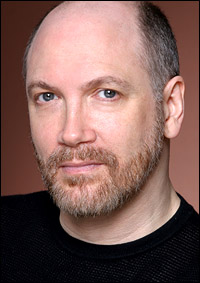Charles Busch--Playwright
The Third Story by
Charles Busch. Produced by Titanic Theatre Company and directed by Adam Zahler.
Featuring Rick Park. With Shelley Brown, Jordan Sobel, Erin Eva Butcher, Alisha
Jansky, and Brett Milanowski. Lighting design by Christopher Brusberg, costume
design by Nancy Stevenson, set design by Marc Harpin, sound design by Michael
Ricca.
At the Arsenal Center for the Arts, Watertown, MA.
Through August 18, 2012. http://titanictheatre.com/.
review by Tom Daley August 12, 2012
After asking us to turn off our cell phones before the show,
the sound director of Titanic Theatre Company’s production of Charles Busch’s The Third Story warned us that there
would be gunshots and strobe lights in the play. He didn’t warn us that we
would spend the rest of the evening with our mouths half-open in astonishment.
I never knew exactly whether to laugh or scream in appreciation of the finesse
with which this story within a story within a story catapults into the
stratosphere of camp and then parachutes back to the tragicomic earth of human
(and inhuman) relations—especially the relationship between child and parent,
between invention and inventor, between creation and creator, and between
original and copy. Everything moved with such speed and finesse that I am still
suffering a bit of whiplash from it all.
In playwright Charles Busch’s scheme, a has-been Hollywood screenwriter worries she may be called to
testify before the House Un-American Activities Committee and begs her son to
collaborate with her on a new screenplay. She hopes a successful partnership
might restore her reputation (or at least pay her bills) and distract her from
worrying over the McCarthyite wolfpack tracking her spoor. Her importuning and
browbeating arouses a lifetime’s worth of resentment from her son, who has
apparently dipped his own toe into the pool of playwriting (his mother, to his
chagrin and outrage, uncovers a brilliant script he’s been hiding at the bottom
of his sock drawer). Recrimination, mutual and assured, escalates as mother
insults son for his taste in girlfriends and son reminds mother that one needs
a scorecard to keep up with all her marital additions and subtractions. There
are more figurative bullet holes in this exchange than in the body of Sonny
Corleone in the tollbooth scene of The
Godfather. But suddenly, both sides set aside their tommy guns to remember,
with a whiff of tenderness, how mother would regale son with Russian folk tales
when he was a kid.
The vitriol of these exchanges furnishes the acid bath in
which the plate of the hoped-for writing joint venture is etched. A reluctant
son embellishes, in spite of himself, his mother’s sketch for the three-tiered
narrative: A witch in the forest creates a twin for a young peasant girl to
lure a Russian prince into a romantic entanglement. A frigid and driven woman
scientist is on the verge of discovering how to create a “double” for an adult
human. A gun moll who has kicked her way into becoming Overlady of the
Underworld tries to bribe the female Dr. Frankenstein into making a copy of her.
She prays the double will survive the malignant tumor that threatens to tear
her away from her son, whom she imagines to be incapable of surviving without
her.
Under the expert direction of Adam Zahler, these three
stories (writing process, fairy tale, gun moll/mad scientist) intertwine with
each other through a series of wittily wrought sleight-of-hand segues and
trompe l’oeil twists. The tales, and the actors who tell them, whiz by on jet
skis, each crisscrossing each other’s wake, jumping into each other’s controls,
bouncing off each other’s waves.




































No comments:
Post a Comment